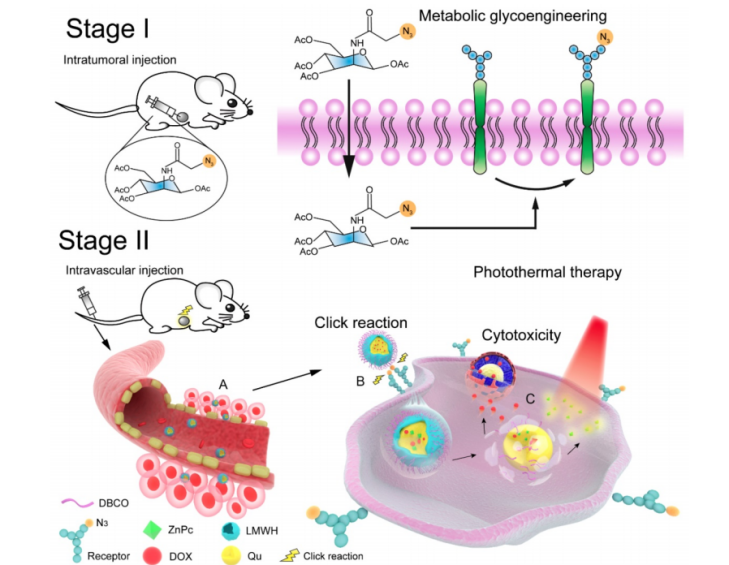文献:Bio-orthogonal click-targeting nanocomposites for chemo-photothermal synergistic therapy in breastcancer
文献链接:https://www.sigmaaldrich.cn/CN/zh/tech-docs/paper/1356086
作者:Jianan Qiao, Fengchun Tian, Yudi Deng, Yunkai Shang, Shijie Chen, Enhao Chang, Jing Yao
相关产品:Cy5-NH2 花菁染料cy5-氨基
原文摘要:Chemo-photothermal synergistic treatment has a high potential to complement traditional cancer therapy and amplify its outcome. Precision in the delivery of these therapeutic agents to tumor cells has been indicated as being key to maximizing their therapeutic effects.
Method: We developed a bio-orthogonal copper-free click-targeting nanocomposite system
(DLQ/DZ) that markedly improved specific co-delivery of the chemotherapeutic agent doxorubicin and the photosensitizer zinc phthalocyanine to breast cancer cells via a two-step mechanism. In the first step, an azide-modified sugar (tetraacetylated N-azidoacetyl-D-mannosamine, Ac4ManNAz) was injected intratumorally for glycoengineering of the tumor cell surface. Subsequently, DLQ/DZ was administered to achieve tumor enrichment via bio-orthogonal copper-free click-targeting.
Results: During the first step in our experiments, high density azide groups (3.23×107 /cell) were
successfully glycoengineered on the surface of tumor cells following Ac4ManNAz administration in vitro. Subsequently, the highly efficient bio-orthogonal click chemical reaction between receptor-like azide groups on tumor cells and DBCO on nanocomposites significantly enhanced the cellular uptake and tumor-specific distribution (4.6x increase) of the nanocomposites in vivo. Importantly, Ac4ManNAz+DLQ/DZ treatment augmented the anti-cancer effect of combined chemotherapy and PTT (96.1% inhibition rate), nearly ablating the tumor.
Conclusions: This bio-orthogonal click-targeting combination strategy may provide a promising
treatment approach for surficial breast cancers.
Cy5-NH2 是一种荧光标记试剂,Cy5-NH2 中的 Cy5 是一种发红色荧光的染料,具有高亮度、高稳定性和良好的光物理性质。其发射波长处于近红外区域,此区域的背景荧光低,能够有效减少干扰,提高检测的灵敏度和准确性。而氨基(-NH2)的存在,使其能够与多种生物分子如蛋白质、核酸等进行共价结合,从而实现对这些生物分子的荧光标记。可用于细胞成像、蛋白质分析、核酸检测等领域。发现生物正交无铜点击靶向纳米复合系统(DLQ/DZ),该系统通过两步机制改善了阿霉素和光敏剂锌酞菁对Breast cancer cells的特异性共递送。制备过程如下:

图:靶向纳米复合材料的设计示意图
DLQ偶联物的合成
将LMWH与NHS和EDC在无水甲酰胺中反应。然后,加入DBCO-NH2溶液搅拌。将反应溶液快速倒入过冷的丙酮中,并沉淀。通过强制过滤提取沉淀,并在蒸馏水中溶解,在透析袋中透析。通过冻干法获得了DBCO-LMWH(DL)偶联物。将Qu接枝到DL上,用与制备DL偶联物相同的方法得到DLQ偶联物。
DLQ-Cy5的合成
DLQ与NHS和EDC在无水甲酰胺中反应。然后,加入Cy5-NH2溶液搅拌。将反应溶液快速倒入过冷的丙酮中,并沉淀。沉淀通过强制过滤提取,溶于蒸馏水中。溶液在透析袋中透析。DLQ-Cy5偶联物通过冻干法获得。
DLQ/DZ纳米复合材料的制备
将DLQ冻干产物溶于蒸馏水中,加入 DOX溶液(DMF)。混合物在充满冰的浴中超声处理。然后,将溶液透析过滤,得到DLQ/DOX纳米复合材料。另外,将DLQ冻干产物溶于蒸馏水中,加入ZnPc溶液(NMP)。混合物在充满冰的浴中超声处理。然后将所得溶液透析过滤,得到DLQ/ZnPc纳米复合材料。最后,将DLQ冻干产物溶于蒸馏水中,加入DOX溶液(以DMF表示)和ZnPc溶液(以NMP表示)。混合物在充满冰的浴中超声处理。然后,透析过滤,得到DLQ/DZ纳米复合材料。

图:DLQ/DZ纳米复合材料的合成与组装工艺。
结论:Cy5-NH2参与制备了一种基于代谢糖工程和生物正交无铜点击化学的靶向联合应用的纳米复合材料。该纳米系统显示出tumor靶向能力,并促进了DOX和光敏剂的靶向共传递。因此,协调的DLQ/DZ纳米复合材料具有良好的抗tumor效果,具有可接受的安全性。

 2025-02-12 作者:ZJ 来源:
2025-02-12 作者:ZJ 来源:

